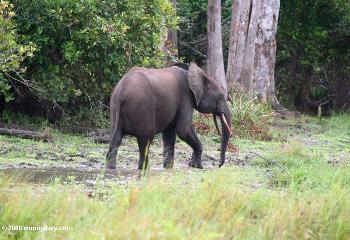Spreading over three central African nations—Cameroon, Central African Republic, and Republic of Congo—the Sangha tri-national landscape is home to a variety of actors: over 150,000 Bantu people and nearly 20,000 pygmies; endangered species including forest elephants and gorillas; and, not least, the Congo rainforest ecosystem itself, which here remains largely intact. Given its interplay of species-richness, primary rainforest, and people—many of whom are among the poorest in the world—the landscape became internationally important in 2002 when under the Congo Basin Forest Partnership (CBFP) conservation groups and development agencies agreed to work together to preserve the ecosystems while providing development in the region.
However, a new study in mongabay.com’s open access journal Tropical Conservation Science finds that the situation remained largely stable, but not greatly improved, until the end of 2008 when the financial crisis spread all the way to central Africa, culling the few jobs available and threatening the forests and species of the Sangha tri-national landscape.
 A forest elephant in Gabon. Photo by: Rhett A. Butler. |
“The aim was to investigate the relationship between the global public goods values of the forests and the livelihoods of local people,” the researchers write of their study.
In examining the efforts of conservation organizations—including the World Wide Fund for Nature (WWF), the Wildlife Conservation Society (WCS), and the International Union for the Conservation of Nature (IUCN)—the study found them wanting in effectively promoting development.
“The activities of conservation organizations did little to improve local livelihoods, and by restricting access to forest resources they may even have had a negative impact on local people. The main determinant of progress in almost all the livelihood indicators was access to employment in logging and timber processing,” the researchers write.
With the financial crisis the situation, which had been largely stable, took a turn for the worse.
“In 2009 the global financial crisis led to a reduction in logging activity and hence of industrial employment and to a neglect of investments in water supplies and roads. Prices of basic products increased markedly in 2009 in all three countries.”
Logging operations laid off workers and cut hours leading to many locals resorting to “poaching and collecting non-timber products to survive”. At the same time organized poaching of forest elephants began to rise, adding an additional threat to the area’s wildlife; and the resulting political instability further affected people and wildlife in the Sangha tri-national landscape.
“The economic downturn therefore had a negative impact on both conservation and development,” the authors conclude starkly.
The researchers believe that in order for conservation organizations to be more effective they should “shift the emphasis of their work towards sustainable forest management and away from simple anti-poaching.”
However, the authors add that in order for forest management activities to sustain local communities, it must be combined with better governance free of corruption—a constant difficulty in the region—and improved regulations to ensure sustainability of logging operations.
According to the study’s authors, “the optimal [Sangha tri-national landscape] would contain larger areas of managed forests with good governance as a matrix within which smaller protected areas could preserve more specific conservation values.”
CITATION: Dominique Endamana, Agni Klintuni Boedhihartono, Bruno Bokoto, Louis Defo, Antoine Eyebe, Cléto Ndikumagenge, Zacharie Nzooh, Manuel Ruiz-Perez6 and Jeffrey A. Sayer. 2010. A framework for assessing conservation and development in a Congo Basin Forest Landscape. Tropical Conservation Science Vol. 3 (3):262-281.
Related articles
Into the Congo: saving bonobos means aiding left-behind communities, an interview with Gay Reinartz

(09/23/2010) Unlike every other of the world’s great apes—the gorilla, chimpanzee, and orangutan—saving the bonobo means focusing conservation efforts on a single nation, the Democratic Republic of the Congo. While such a fact would seem to simplify conservation, according to the director of the Bonobo and Congo Biodiversity Initiative (BCBI), Gay Reinartz, it in fact complicates it: after decades of one of world’s brutal civil wars, the DRC remains among the world’s most left-behind nations. Widespread poverty, violence, politically instability, corruption, and lack of basic infrastructure have left the Congolese people in desperate straits.
Protected areas vital for saving elephants, chimps, and gorillas in the Congo
(05/10/2010) In a landscape-wide study in the Congo, the Wildlife Conservation Society (WCS) found that core protected areas and strong anti-poaching efforts are necessary to maintain viable populations of forest elephants, western lowland gorillas, and chimpanzees—all of which are threatened with extinction.
Population density corresponds with forest loss in the Congo Basin
(03/29/2010) Africa’s greatest rainforest ecosystem, the Congo Basin, has undergone significant deforestation and degradation during the past century. A new study in the open access journal Tropical Conservation Science examined whether or not there was a connection between population density and forest loss.